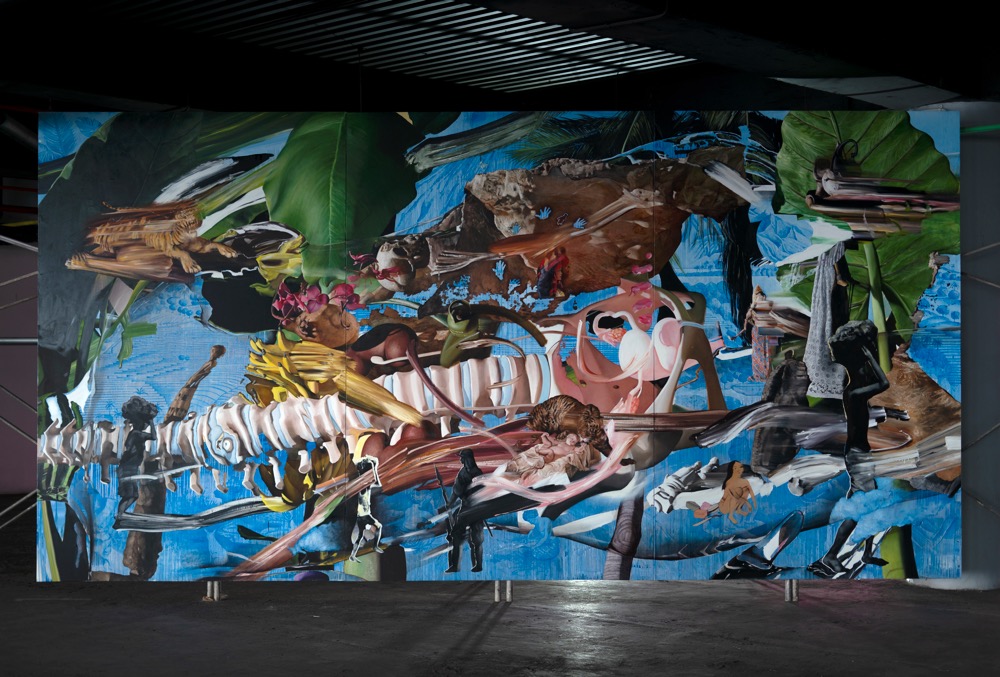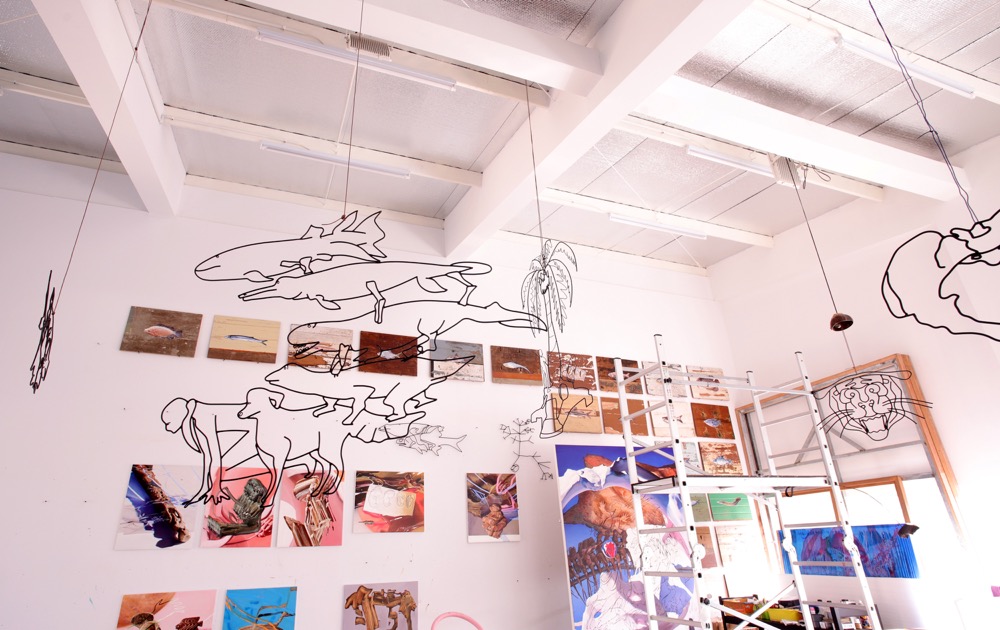
Kei Imazu
Solo Exhibition
Mapping the Land/Body/Stories of its Past
10.2 (Sat) - 11.7 (Sun), 2021
Open on Tue, Wed, Thu, Fri, and Sat. 12:00 – 18:00
Closed on Sundays, Mondays, and National holidays, except November 7.
* To protect public health against COVID-19, we will suspend the reception event.
We at ANOMALY are pleased to announce an upcoming solo exhibition of works by Kei Imazu titled Mapping the Land/Body/Stories of its Past, running from Saturday, October 2 to Sunday, November 7, 2021.
Kei Imazu explores the relationship between corporeality in painting and contemporary visual expression. She produces paintings in the following way: she first rearranges images mined from various media using computer applications, and then transfers them to the canvas using oil paints.
All of Imazu’s works are bursting with strong emotions that well up inside her in everyday life and personal happenings, presented in the guise of motifs. She nevertheless creates paintings imbued with an objectivity, by carefully going back and forth between technique and theme.
For the new works to be displayed in this exhibition, Imazu used not only Photoshop®, which she has used in the past, but also the singularity of the theory behind the drawing space in Dimension®, a 3D rendering software. The paintings are composed of all sorts of fragmented image data, and have a peculiar depth or flatness. They call to mind the artificial computing space of the contemporary age, differing slightly from the realistic perspective of conventional painting.
While deriving from the personal knowledge and experience of Imazu, whose activities are now based in Indonesia, Mapping the Land/Body/Stories of its Past was also inspired partly by indigenous/different cultures and the works of female authors, including Josei gaka retsuden (Lives of female artists) by Midori Wakakuwa*1), Chaos, Territory, Art: Deleuze and the Framing of the Earth by Elizabeth Grosz*2), and Onna ga gakusha ni naru toki: Indonesia kenkyu funtoki (When a woman becomes a scholar: Journal of an Indonesian research struggle) by Aiko Kurasawa*3)
At the start of her book, Grosz wonders when and how art began as a material and conceptual structure in the context of the history of bio-evolution. In her book, works of art manifest an absorption in generation and continuation, and appear as contracted conditions for the present to overcome the future. In spite of being the indigenous inhabitants, people will reframe even the history of a colony built by foreigners as a living entity supporting their land, and the memory of that land.
For example, the work of an Aboriginal artist may look like an Op Art abstract painting, with fine dots covering the canvas. Let us say that these works are transcriptions onto canvas of an attempt at “ritual dreaming” (a form of mapping) drawing on things linked to the artist’s own body and the history of the ethnic group (e.g., topography, animals, wars, natural disasters, birth, marriage, ancestors, and totems). There is a connection here with Imazu’s own doings in Indonesia. When she moved there about three years ago, she often felt bewildered and uneasy when confronted with unfamiliar things and places. In those days, she would make paintings by relying on the memory and experience of her own body. Similarly, after she gave birth to a child whose roots also lay in Indonesia, she thought of mapping the history of the child’s motherland on motifs in paintings.
In the land to which she emigrated, Imazu experienced many things, including childbirth and child-raising, the evolution and extinction of creatures, a colonial history, and earth-mother worship. She positioned these things on the canvas to serve as triggers for the recollection of the history of the past, and thereby framed them as paintings. This could be termed akin to the process of dreaming inclusive of contemplation which looks to the future.
It may also be noted that Imazu enhances texture by various effects on the surface of the object in the 3D image created by computer graphics. Coupled with the rendering effect of Dimension® and the strokes that she physically applies with a brush, her procedure could presumably be regarded as a kind of mapping.
The idea for the new work Memories of the Land/Body came from the mapping pointed out by Grosz. Imazu made extensive use of texture mapping and bump mapping to produce various effects on object surfaces by means of 3D images from computer graphics made with Dimension®, and incorporated this into the production process.
For example, in the background of Memories of the Land/Body, Imazu references a painting of Gunung Sumbing, a volcano on the island of Java, by the Dutch geologist Franz Wilhelm Junghuhn. The act of making maps was once motivated by the aim of assisting efforts by Western powers to colonize “uncivilized” lands and efficiently increase their production capacities. In this sense, the mapping done in Indonesia by the Dutch East India Company in colonial days and by the Japanese army during World War II may be considered an indicator of territorial expansion.

Memories of the Land/Body, 2020, oil on linen, H.200xW.600cm ©︎Kei Imazu
For RIB, Imazu transferred flat, 2D motifs sampled from the pictures of artists appearing in Josei gaka retsuden to 3D space with depth. A paragraph with the heading “Did women make pottery?” in this work contains the following passage: “Sitting on the ground in the shade with her legs stretched out and a baby nursing at her breast, the woman deftly made an urn and expertly wielded a cord to decorate it with a pattern, all the while talking in a loud voice and scolding her children”*4). RIB was born of the empathy Imazu felt for the text grounded in earnest sentiments expressed by the author in the afterword of this book as she experienced childbirth and child-raising in another country while struggling with physical and temporal constraints that were not there before.

RIB, 2021, oil on linen, H.200xW.300cm ©︎Kei Imazu
The works in this exhibition are also symbolic of global problems arising from the Global South issue that was brought home to the artist through her experiences and discoveries living in Indonesia after making it the base of her activities. The structural outlines and overlapping motifs that she has continued to ponder in recent years dovetail with the distortion of the world in the modern age due to repeated resource exploitation and environmental destruction by developed countries, and the wriggling of natural selection in weeding out organisms over a long time span, through the processes of evolution and extinction.
Imazu conceived motifs appearing in her art from the ecosystem, using the circulation of water as a metaphor. They likewise appear again and again as part of her installations, while morphing into items such as steel mobiles and wallpaper.

Scene of the artist’s studio in Bandung, 2021
Born in Yamaguchi Prefecture in 1980, Kei Imazu currently lives in Bandung, Indonesia. After receiving a master’s degree from Tama Art University, she received the Honorable Mention Award in the VOCA 2009 exhibition. A large work of hers more than four meters long was acquired by the Minneapolis Institute of Art for its collection in 2017, and she was selected to be one of the finalists for the Prix Jean-François Prat, the French award supporting pictorial expression in the contemporary age, in 2020. As this evidences, she has attracted keen attention outside as well as inside Japan.
In 2019, an installation titled Artificial green by nature green, which she created in collaboration with the Indonesian artist Bagus Pandega, was shown at the ArtJog MMXIX: Art in Common exhibition in Yogyakarta. In this work, which has a temporal axis, a water-soaked brush whose operation is interlocked with the organic electrical current of a palm tree strokes a green-wash panel, and the silhouette of an orangutan emerges from beneath the green. It is based on data indicating that the large-scale destruction of forests on the islands of Sumatra and Kalimantan, which constitute one of the 11 regions in the world contributing to the global eco-system, is threatening the subsistence of thousands of species and causing land erosion and flooding. In short, this installation was an attempt to present a phenomenon associated with global climate change, and garnered high acclaim.
Notes:
*1)Midori WAKAKUWA, Josei gaka retsuden (Lives of female artists), Iwanami Shoten, Publishers, 1985.
*2)Elizabeth GROSZ, Chaos, Territory, Art: Deleuze and the Framing of the Earth, Japanese translation published by Hosei University Press, 2020.
*3)Aiko KURASAWA, Onna ga gakusha ni naru toki: Indonesia kenkyu funtoki, (When a woman becomes a scholar: Journal of an Indonesian research struggle), revised edition, Iwanami Shoten, Publishers, 2021.
*4)Tentative translation of a quotation from Sabanna no hakubutsushi (A natural history of savannas; Junzo KAWADA, Shincho Sensho) in Midori WAKAKUWA, op. cit., p. 173
Born in Yamaguchi, 1980. Lives and works in Bandung, Indonesia.
Imazu draws on a range of sources for the imagery within her artwork: from renowned masterpieces, illustrated museum catalogues, encyclopedias and even trivial photos found on social media. Taking these images and editing them in Photoshop she makes a preliminary sketch in preparation for the oil paintings she goes on to make.
Her method almost stands in contradiction to the work she produces; the energetic and seemingly free brush strokes are in fact precisely pre-arranged employing the digital software available to her. Glitches, which are created by the processing of heavy data, and the familiar-looking image of the software window, things that nowadays we see on a daily basis, have become striking motifs in her paintings.
Development in technology has always brought a change to human perception, especially in relation to art since even prehistoric times. Imazu’s work both in its creation and in its final manifestation is a reflection of this. However, in the midst of the accelerated development in computer graphics and smart phones – things now seen as essentials – Imazu’s work seeks to acquire updated viewpoints on art history by encompassing self-consciousness and reaction to this current spatial arena and its objects. Through the distorted and intertwined images depicted on the canvas, viewers witness a trace of the long time the artist pursued a deep contemplation of the notion of painting itself.
In 2009, Imazu was awarded Prize for Excellence at VOCA, and Encouragement Award at the 5th Kinutani Koji Award. A painting of hers that measures over 4 metres in length was recently acquired by the Minneapolis Institute of Art in 2017. In 2020, Prix Jean François Prat (France), the prize to promote contemporary painting nominated her as a finalist.
Notification of precautions and requests
To prevent the spread of COVID-19, and to ensure the safety of visitors, artists, staff, and the community in compliance with the government’s health guidelines, please take a moment for the following requests upon your visit.
To avoid three C’s (Closed and Crowded place, Close contact), please refrain from visiting the gallery in large groups.
Visitors are asked to wear masks and sanitize hands before entering the gallery. Hand sanitizer is available at the entrance.
Please refrain from visiting the gallery if you have symptoms such as a fever (37.5°C or higher) or cough.
Our staff will have temperatures taken before coming to work to check health conditions every day, and will guide you by adopting frequent hand hygiene and wearing masks.
The entire space will be regularly ventilated and we will disinfect the high-touch areas.
Please check our website or SNS for the latest information about opening hours, as we may change it or close the gallery in unpredictable circumstances.
We appreciate your cooperation.

























































































